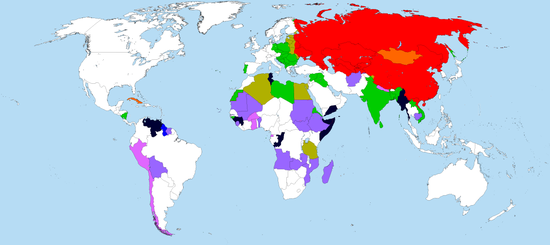Types of Constitution in Nigeria – Full Details
Types of Constitution in Nigeria – Full Details. In this article, you’ll learn the different types of constitution in Nigeria and their details. In Nigeria, the constitution of the Federal Republic of Nigeria is supreme and binding.
What Is Constitution?
A constitution is an aggregate of fundamental principles or established precedents that constitute the legal basis of a polity, organisation or other type of entity and commonly determine how that entity is to be governed. A constitution also guides the decisions of government, defines the sovereign powers of a country, and guarantees individual civil rights and liberties, superseding every other law of a country or state.
A society’s constitution is a very important feature. It is a country’s entire system of government, a set of rules that define, control, and govern the government. The value of a country’s Constitution cannot be overstated.
Typically, constitutions contain the basic laws and principles of nations, social groups, or states. These instruments also determine the duties and powers of those in office and safeguard the rights of the people. As with other different aspects that define nations, there are various types of constitutions in different parts of the world.
In Nigeria, the Constitution of the Federal Republic of Nigeria is supreme and binding on all citizens. It defines the functions of government, protects citizens’ human rights, and guarantees that no one violates the rules and regulations enshrined in it.
See Also: List Of 774 Local Governments In Nigeria
What Type Of Constitution Does Nigeria Operate?
The Federal Republic Of Nigeria Operates a Rigid And Written Constitution.
Now that you know the type of constitution Nigeria is currently operating, let’s quickly look at the various types of constitutions in Nigeria.
Types Of Constitution In Nigeria
Here are the four (4) types of constitutions.
-
Rigid Constitution
-
Flexible Constitution
-
Written Constitution
-
Unwritten Constitution
1) Rigid Constitution
A Rigid constitution is a constitution that is difficult to be amended or slow to change usually because of a prescribed process of the amendment that is detailed and lengthy in execution.
A rigid constitution contributes to political stability.
A rigid constitution cannot be misused by the government having the support of a simple majority in the national legislature.
A rigid constitution protects the fundamental rights of the individual.
A rigid constitution is good for a federal system of Government like Nigeria because neither the centre nor the Federal units can easily change it to their advantage.
2) Flexible Constitution
A flexible constitution is an opposite of a rigid constitution.
A flexible constitution can easily be amended.
A flexible constitution is a constitution that is not defined or set apart in a distinct document and that is not distinguishable from other laws in the way in which its terms can be legislatively altered.
The constitution of England is a typical example of a flexible constitution.
3) Written Constitution
A Written Constitution refers to the constitution codified and compiled in a single document.
The Nigerian constitution is written in a single document and it’s a typical example.
A written constitution is very clear and precise. It is free from doubts and ambiguity, it also lays emphasis on rule of law.
A written constitution is indispensable to federalism. It properly distributes powers between the centre and federal units – states or provinces.
A written constitution also protects the fundamental rights of the citizens.
4) Unwritten Constitution
An unwritten Constitution is an opposite of a written constitution.
An unwritten constitution is not written down in a single document and it’s easy to be amended.
An uncodified constitution is a type of constitution where the fundamental rules often take the form of customs, usage, precedent, and a variety of statutes and legal instruments.
An understanding of the constitution is obtained through reading commentary by the judiciary, government committees, or legal experts.
See Also: Top 10 Causes and Solutions to Insecurity in Nigeria
Other Types Of Constitution
5. Monarchy and Republican Constitution
Monarchy is a peculiar constitutional structure that entails the practice of a head of state, with the Prime Minister wielding political power. Whereas the president, who serves as both the head of state and the head of government, is elected under the Republican Constitution.
6. Federal and Unitary Constitution
In Unitary Constitution, power is Concentrated at the centre although it can still provide for delegation of power to the Local level. The Federal Constitution allows for the sharing of power among the three branches of government as well as the creation of government at other levels (State and local)
7. Political and Legal Constitution
Political constitutions are based on the principle of majoritarianism and concern the group of citizens who hold political power in a society. They argue that legislation affecting the masses should be enacted by an elected majority. The legal constitution is under the jurisdiction of the judiciary, which has the power to modify or amend it.
8. Codified and Uncodified Constitution
This is another name for written and unwritten Constitution. Codified Constitution provides the institution to effect Constitutional changes, although such changes are not usually easy . But when we refer to uncodified Constitution, it is not enstrench in a documents which does not afford easy access.
9. Presidential and paliamentary Constitution
In our society today, it is the presidential system of government that is in operation. This entails the Democratic system of government where the head of government heads an executive branch which is quite distinct from the legislative branch. Here the head of government is also the head of State.
Its worthy to note that the Constitution of Nigeria is contained in a single document.
See Also: The List of Political Parties in Nigeria (Complete List)
Sources of Constitution in Nigeria.
The Constitution of Nigeria derives it source from the following
- Judicial precedent (Rulings of the court in Nigeria)
- Opinions of political and constitutional Writers.
- Customs and Conventions and Constitutions of other Countries.
- Nigerian constitution
Interestingly, Constitutional development in Nigeria has been in place since 1914. The Colonial era span from 1914 to 1960. The first Constitution was enacted by an Order in council which was approved by the British colonial government when the country was administered as a Crown Colony during the Colonial administration. The following are a few of the constitutions passed during that era. They are listed here
- The 1913 Constitution. It which came into force in January 1914
- The Clifford Constitution (1922)
- The Richard Constitution (1946)
- The MacPherson Constitution (1951)
- The Lytyledon Constitution (1954). It solidified the federal concept and paved the way for the country’s independence.
Nigeria has a number of Constitutions that were adopted after the country achieved independence. They are the following
1. The 1960 (Independence) Constitution.
It was enacted by a British Order in council and it came into force on October 1, 1960. Nigeria still retained Queen Elizabeth 11 as titular head of State.
2. The 1963 ( First Republican)Constitution
3. The 1979 (Second Republican) Constitution
4. The 1993 (Third Republican)Constitution
Note that the 1993 constitution, which called for the creation of a Third Republic and the restoration of democratic rule to Nigeria, was never completely enforced, and the military regained power until 1999.
5. The 1990 Constitution.
See Also: List Of Land Borders In Nigeria
The current constitution was enacted on 29 May 1999, inaugurating the Nigerian Fourth Republic The 1993 constitution was intended to see the return of democratic rule to Nigeria with the establishment of a Third Republic, but was never fully implemented, and the military resumed power until 1999.
Conclusion
The different types of constitutions have their merits and demerits and instances in which they are best suited. To date, none seems overly superior to the other, as proven by the existence of the different types in various countries worldwide.
Now that you know the various types of constitutions kindly share them with others.
We Believe This Article Was Helpful, Don’t Hesitate To Share This Information With Your Friends On Facebook, Twitter, Whatsapp and Google plus.
Copyright Warning: Contents on this website may not be republished, reproduced, redistributed either in whole or in part without due permission or acknowledgement. All contents are protected by DMCA.
The content on this site is posted with good intentions. If you own this content & believe your copyright was violated or infringed, make sure you contact us via This Means to file a complaint & actions will be taken immediately.




